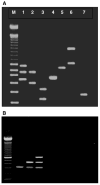Pathotypes of diarrheagenic Escherichia coli in children attending a tertiary care hospital in South India
- PMID: 20846583
- PMCID: PMC3918514
- DOI: 10.1016/j.diagmicrobio.2010.06.003
Pathotypes of diarrheagenic Escherichia coli in children attending a tertiary care hospital in South India
Abstract
The prevalence of diarrheagenic Escherichia coli (DEC) in children under 5 years was studied in children with diarrhea and controls in South India. Four polymerase chain reaction (PCR) "schemes" were used to detect genes of the 6 pathotypes of DEC. In 394 children with diarrhea, 203 (52%) DEC infections were found. Among the 198 controls, 126 (63%) DEC infections were found. Enteroaggregative E. coli was the most common pathotype by multiplex PCR both in cases (58, 14.7%) and controls (47, 23.7%), followed by enteropathogenic E. coli seen in 10% cases and 8% of controls. Enterotoxigenic E. coli (ETEC), enterohemorrhagic E. coli (EHEC), enteroinvasive E. coli (EIEC), and diffusely adherent E. coli (DAEC) were found in 4.1%, 2.0%, 1.0%, and 0.5% of cases, respectively. ETEC was found in 2.5% of controls, but EHEC, EIEC, and DAEC were not detected. Overall, no single assay worked well, but by discounting genes with a pathogenicity index of less than 1, it was possible to use the PCR assays to identify DEC in 75/394 (19%) cases and 12/198 (6.1%) controls, while mixed infection could be identified in 8/394 (2%) cases and 2/198 (1%) controls.
Copyright © 2010 Elsevier Inc. All rights reserved.
Figures

Similar articles
-
Molecular characterization of diarrheagenic Escherichia coli from Libya.Am J Trop Med Hyg. 2012 May;86(5):866-71. doi: 10.4269/ajtmh.2012.11-0330. Am J Trop Med Hyg. 2012. PMID: 22556089 Free PMC article.
-
Low frequency of enterohemorrhagic, enteroinvasive and diffusely adherent Escherichia coli in children under 5 years in rural Mozambique: a case-control study.BMC Infect Dis. 2020 Sep 7;20(1):659. doi: 10.1186/s12879-020-05380-1. BMC Infect Dis. 2020. PMID: 32894092 Free PMC article.
-
Prevalence, phylogeny, and antimicrobial resistance of Escherichia coli pathotypes isolated from children less than 5 years old with community acquired- diarrhea in Upper Egypt.BMC Infect Dis. 2020 Dec 1;20(1):908. doi: 10.1186/s12879-020-05664-6. BMC Infect Dis. 2020. PMID: 33256619 Free PMC article.
-
Updates on defining and detecting diarrheagenic Escherichia coli pathotypes.Curr Opin Infect Dis. 2020 Oct;33(5):372-380. doi: 10.1097/QCO.0000000000000665. Curr Opin Infect Dis. 2020. PMID: 32773499 Free PMC article. Review.
-
Diarrheagenic Escherichia coli in sub-Saharan Africa: status, uncertainties and necessities.J Infect Dev Ctries. 2009 Nov 27;3(11):817-42. doi: 10.3855/jidc.586. J Infect Dev Ctries. 2009. PMID: 20061678 Review.
Cited by
-
Enteric pathogens associated with childhood diarrhea in Tripoli-Libya.Am J Trop Med Hyg. 2011 Jun;84(6):886-91. doi: 10.4269/ajtmh.2011.11-0116. Am J Trop Med Hyg. 2011. PMID: 21633024 Free PMC article.
-
Epidemiology and clinical manifestations of enteroaggregative Escherichia coli.Clin Microbiol Rev. 2014 Jul;27(3):614-30. doi: 10.1128/CMR.00112-13. Clin Microbiol Rev. 2014. PMID: 24982324 Free PMC article. Review.
-
Characteristics of Pathogenic Escherichia coli Associated with Diarrhea in Children under Five Years in Northwestern Ethiopia.Trop Med Infect Dis. 2024 Mar 21;9(3):65. doi: 10.3390/tropicalmed9030065. Trop Med Infect Dis. 2024. PMID: 38535888 Free PMC article.
-
High prevalence of diarrheagenic Escherichia coli carrying toxin-encoding genes isolated from children and adults in southeastern Brazil.BMC Infect Dis. 2017 Dec 18;17(1):773. doi: 10.1186/s12879-017-2872-0. BMC Infect Dis. 2017. PMID: 29254489 Free PMC article.
-
Escherichia coli pathotypes and Shigella sero-groups in diarrheic children in Nairobi city, Kenya.Gastroenterol Hepatol Bed Bench. 2017 Summer;10(3):220-228. Gastroenterol Hepatol Bed Bench. 2017. PMID: 29118939 Free PMC article.
References
-
- Al-Gallas N, Bahri O, Bouratbeen A, Ben Haasen A, Ben Aissa R. Etiology of acute diarrhea in children and adults in Tunis, Tunisia, with emphasis on diarrheagenic Escherichia coli: prevalence, phenotyping and molecular epidemiology. Am J Trop Med Hyg. 2007;77:571–582. - PubMed
-
- Ballal M, Ramamurthy T. Enteroaggregative Escherichia coli diarrhea in Manipal. Indian Pediatr. 2005;42:722–723. - PubMed
-
- Baudry B, Savarino SJ, Vial P, Kaper JB, Levine MM. A sensitive and specific DNA probe to identify enteroaggregative Escherichia coli, a recently discovered diarrheal pathogen. J Infect Dis. 1990;61:249–251. - PubMed
MeSH terms
Substances
Grants and funding
LinkOut - more resources
Full Text Sources
Medical
Research Materials

